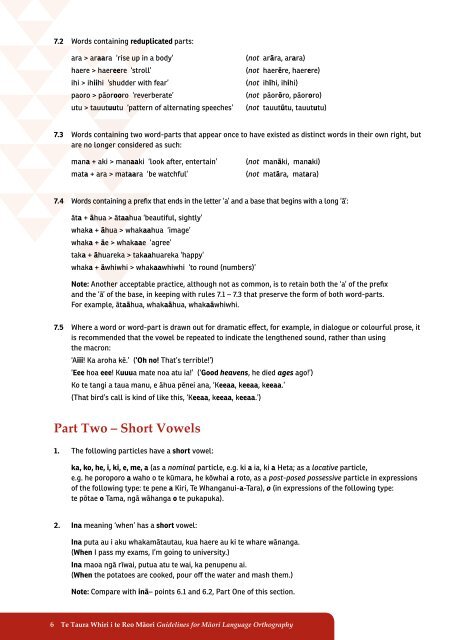Guidelines_for_Maori_Language_Orthography
Guidelines_for_Maori_Language_Orthography
Guidelines_for_Maori_Language_Orthography
You also want an ePaper? Increase the reach of your titles
YUMPU automatically turns print PDFs into web optimized ePapers that Google loves.
7.2 Words containing reduplicated parts:<br />
ara > araara ‘rise up in a body’<br />
haere > haereere ‘stroll’<br />
ihi > ihiihi ‘shudder with fear’<br />
paoro > pāorooro ‘reverberate’<br />
utu > tauutuutu ‘pattern of alternating speeches’<br />
(not arāra, arara)<br />
(not haerēre, haerere)<br />
(not ihīhi, ihihi)<br />
(not pāorōro, pāororo)<br />
(not tauutūtu, tauututu)<br />
7.3 Words containing two word-parts that appear once to have existed as distinct words in their own right, but<br />
are no longer considered as such:<br />
mana + aki > manaaki ‘look after, entertain’<br />
mata + ara > mataara ‘be watchful’<br />
(not manāki, manaki)<br />
(not matāra, matara)<br />
7.4 Words containing a prefix that ends in the letter ‘a’ and a base that begins with a long ‘ā’:<br />
āta + āhua > ātaahua ‘beautiful, sightly’<br />
whaka + āhua > whakaahua ‘image’<br />
whaka + āe > whakaae ‘agree’<br />
taka + āhuareka > takaahuareka ‘happy’<br />
whaka + āwhiwhi > whakaawhiwhi ‘to round (numbers)’<br />
Note: Another acceptable practice, although not as common, is to retain both the ‘a’ of the prefix<br />
and the ‘ā’ of the base, in keeping with rules 7.1 – 7.3 that preserve the <strong>for</strong>m of both word-parts.<br />
For example, ātaāhua, whakaāhua, whakaāwhiwhi.<br />
7.5 Where a word or word-part is drawn out <strong>for</strong> dramatic effect, <strong>for</strong> example, in dialogue or colourful prose, it<br />
is recommended that the vowel be repeated to indicate the lengthened sound, rather than using<br />
the macron:<br />
‘Aiii! Ka aroha kē.’ (‘Oh no! That’s terrible!’)<br />
‘Eee hoa eee! Kuuua mate noa atu ia!’ (‘Good heavens, he died ages ago!’)<br />
Ko te tangi a taua manu, e āhua pēnei ana, ‘Keeaa, keeaa, keeaa.’<br />
(That bird’s call is kind of like this, ‘Keeaa, keeaa, keeaa.’)<br />
Part Two – Short Vowels<br />
1. The following particles have a short vowel:<br />
ka, ko, he, i, ki, e, me, a (as a nominal particle, e.g. ki a ia, ki a Heta; as a locative particle,<br />
e.g. he poroporo a waho o te kūmara, he kōwhai a roto, as a post-posed possessive particle in expressions<br />
of the following type: te pene a Kiri, Te Whanganui-a-Tara), o (in expressions of the following type:<br />
te pōtae o Tama, ngā wāhanga o te pukapuka).<br />
2. Ina meaning ‘when’ has a short vowel:<br />
Ina puta au i aku whakamātautau, kua haere au ki te whare wānanga.<br />
(When I pass my exams, I’m going to university.)<br />
Ina maoa ngā rīwai, putua atu te wai, ka penupenu ai.<br />
(When the potatoes are cooked, pour off the water and mash them.)<br />
Note: Compare with inā– points 6.1 and 6.2, Part One of this section.<br />
6 Te Taura Whiri i te Reo Mäori <strong>Guidelines</strong> <strong>for</strong> Mäori <strong>Language</strong> <strong>Orthography</strong>


